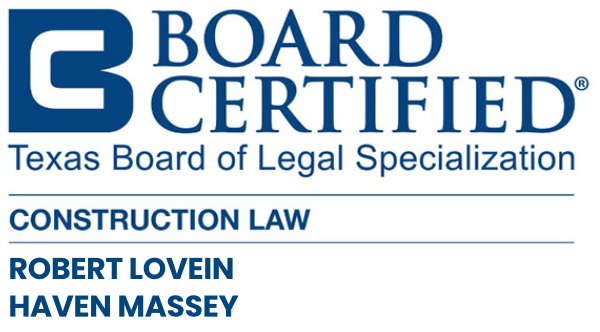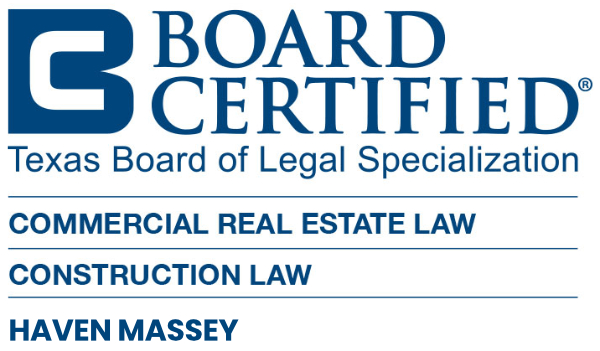The Texas Board of Legal Specialization has certified approximately 150 Texas lawyers as Board Certified in Construction Law. Lovein Ribman’s construction law department is overseen by two of those Board Certified attorneys. Our construction law attorneys counsel and represent commercial and residential property owners, architects, engineers, developers, sureties, general contractors, subcontractors, and suppliers with every type of legal issue encountered on commercial, industrial, residential and public construction projects. Our construction attorneys have been tried and tested, and are experienced in all aspects of construction law, to include enforcing payment through the mechanics lien and bond claim process; removing invalid mechanic’s liens; lien foreclosure actions; defending and/or prosecuting design and construction defect claims; delay damage claims; and with drafting, reviewing, and modifying all types of residential and commercial contracts. We understand the industry. We listen to your needs. We will add value to your company.
Texas Mechanic’s Lien Laws
Texas mechanic’s liens laws are among the most complex lien laws in the Nation. To compound the complexity, Texas courts require the lien claimant to strictly follow the lien laws in order to perfect a valid lien against a property. Despite that, the county clerk’s office (the location where liens are filed) will not review the lien affidavit prior to recording it to determine whether the lien claimant is entitled to a lien or has satisfied all of the lien laws. As a result, thousands of invalid liens are recorded on a monthly basis.
Given the complexity of our lien laws, it is not uncommon for non-construction law attorneys, online lien filing services, and contractors to wrongfully threaten, actually file, and/or maintain an invalid and unenforceable mechanic’s lien. Unfortunately for the property owner, once a lien has been filed, valid or not, it will likely prevent the property owner from selling or refinancing the property, or converting a construction loan to a conventional loan. For a commercial tenant, the lien will likely place the tenant in default of its lease and prevent the release of any tenant finish-out monies. For general contractors, when a subcontractor or material supplier files a lien, it will typically place the contractor in breach of its contract and suspend future payments. In fact, a general contractor is required to defend and indemnify the property owner against a mechanic’s lien; meaning the general contractor is legally obligated to pay for the removal of the lien. With that said, you can see how powerful mechanic’s liens can be for a lien claimant; however, when a lien claimant threatens to file or files an invalid lien, the power shifts to the property owner in that the courts will impose harsh sanctions against a lien claimant who knowingly files and/or maintains an invalid lien as leverage for payment. We have removed thousands of invalid residential and commercial liens. If you have been threatened with a lien or need to remove an invalid lien, please contact us for a no obligation consultation by calling (888) 368-2483 or by submitting the contact form below. Read on to learn more about the lien removal process.
The Basis to Invalidate a Mechanic’s Lien
Subcontractor’s Failure to Serve or Timely Serve an Intent to Lien: All subcontractors, material suppliers, and laborers, must timely serve an intent to lien (pre-lien notice) before recording the lien affidavit. General contractors (anyone hired by the property owner) are not required to serve any preliminary notice before recording a mechanic’s lien. Failure to timely serve the intent to lien, will render the lien invalid. On residential properties, the intent to lien must be served on the property owner and the general contractor by no later than the 15th day of the second month, from each and every month, the lien claimant provided unpaid labor/materials to the property. For example, if the lien claimant provided unpaid work in January, then the intent to lien must be served by no later than March 15th.
On commercial projects, the 1st tier lien claimant (anyone hired by the general contractor) has an additional month to serve the notice, or the 15th day of the third month from each and every month that the lien claimant provided unpaid labor/materials to the project. To make it more complicated, on commercial projects, anyone hired by a subcontractor (as opposed to the general contractor) has an additional intent to lien notice requirement, wherein they must serve the general contractor only, with notice of the unpaid amount by no later than the 15th day of the second month from each and every month work was performed but not paid. Taking the above example, the second-tier lien claimant would be required to notify the general contractor of the unpaid work performed in January, by no later than March 15. A second-tier lien claimant can combine the two notices into one, but only if the notice is sent by the earlier of the two dates.
To add one other layer of complexity, subcontractors whose work is performed at the end of a project, must serve the intent to lien before the property owner releases final payment to the general contractor, even if the deadline to serve the intent to lien has not passed. A property owner may release all construction funds after 30 days from achieving substantial completion.
Failure to serve or timely serve a pre-lien notice is one of the most common ways to defeat or reduce the amount of a mechanic’s lien.
Failure to Include the Required Statutory Language in the Intent to Lien: A intent to lien must include certain statutory language in order to be valid. On commercial properties, this requirement is easily satisfied by advising the property owner that if it fails to withhold the amount claimed owed from the general contractor, it may become personally liable for the debt and made to pay twice. On residential homestead properties, the statutory notice requirements are more substantial and consist of three lengthy paragraphs, which are rarely included in the notice unless prepared by a construction attorney.
Failure to Timely Record the Lien Affidavit: On residential properties, a direct contractor (one hired by the property owner) has until the 15th day of the third month from completion, abandonment, termination, or suspension of the work to record a statutory lien affidavit. On commercial properties, the direct contractor has an additional month, or the 15th day of the fourth month from completion, abandonment, termination, or suspension of the work. However, most direct contractors are also entitled to file a Texas Constitutional lien, which can be recorded within 4 years from completion, abandonment, termination, or suspension of the work. To be entitled to a Constitutional lien, the direct contractor must have provided labor or materials to improve the actual structure and the property must not have been sold to a good faith purchaser (someone who was not aware of the debt) before the lien is recorded. A direct contractor does not have a right to record a Constitutional lien for the following type of work: design services, architectural services, engineering services, earth work, fencing, pool construction and maintenance, landscaping, irrigation, water wells, or paving exterior to the structure.
Subcontractors must follow the same deadlines as general contractors, but their deadline begins to accrue when they have completed their portion of the work, or have been terminated or abandoned the project, as opposed to when the overall project was completed. A subcontractor’s deadline to file its lien affidavit, can also be reduced when the direct contractor has been terminated from the project.
Failure to Include the Necessary Information in the Lien Affidavit: A properly prepared lien affidavit must include: (1) the identity of the claimant; (2) the identity of the property owner; (3) a description of the property, such as address, lot/block, meets and bounds; (4) the amount owed; (5) a description of the unpaid work; (6) identification as to when the unpaid work was performed or completed; (7) if a subcontractor, the date and method for serving the intent to lien and who it was served on; (8) a notarized sworn statement that the information contained in the affidavit is true and correct. Generally, failure to include any of the aforementioned information will invalidate the lien.
Failure to Follow the Homestead Requirements: It is not easy to perfect a lien on a homestead property and most liens filed on a homestead are in fact invalid. However, if the rules are followed, then a lien claimant can actually foreclose (sell) a residential homestead property to pay the amount of the lien affidavit. With that said, the two most important requirements for perfecting a lien against a homestead property are: (1) the direct contractor must have a written contract signed by both spouses (if a married couple) before any work has been performed; and (2) the contract must be recorded with the county clerk’s office. If these two requirements have not been satisfied then the direct contractor and anyone working under the direct contractor, are not entitled to record a valid lien against the property.
Failure to Timely Serve the Lien Affidavit: After the lien has been recorded, the lien claimant must serve the property owner with the lien affidavit by certified mail, or its equivalent, within 5 business days from recording the lien. Failure to do so will invalidate the lien.
Failure to File a Lawsuit to Foreclose: Recording and serving the lien affidavit is not the last step. A lien claimant must file a lawsuit to foreclose the lien; meaning prove up it is actually entitled to the money claimed owed and that it followed all applicable lien laws. For residential properties, the lawsuit must be filed within 1 year from the last date that the lien affidavit could be filed and on commercial properties, 2 years from the last date the lien affidavit could be filed. Generally speaking, this deadline tends to run approximately 1 or 2 years from when the lien was recorded since most lien claimants wait until the last date to record the lien. If a lawsuit is not filed within these deadlines, the lien becomes invalid even if all other lien laws have been satisfied.
Methods for Defeating and Removing an Invalid Lien Claim
Informal Demand to Release Lien: By far, the most expeditious and least expensive method to defeat a contractor’s threat to file an invalid lien or remove an already filed invalid lien, is to prepare and send the lien claimant a demand that thoroughly outlines the lien laws, defects with the lien documents, and the sanctions that will be sought and imposed by the court if the invalid lien is filed and/or not immediately removed. Over the years we have found this option to be very effective.
Lawsuit to Remove an Invalid Lien: By far the most expensive and time-consuming option, but necessary if the lien claimant will not voluntarily release the lien. Through this process, a lawsuit is filed against the lien claimant, along with a Motion to Remove the lien. At a minimum, this process can take up to 3-4 months. If the court grants the motion, the plaintiff is entitled to recover its attorneys’ fees and costs incurred to remove the lien. In addition, if you demonstrate that the lien claimant knowingly filed an invalid lien with the intent to cause you harm, then you may be entitled to a minimum $10,000.00 in sanctions or actual damages if higher than $10,000.00.
Deposit the Lien Amount with the Court: A lien can be removed from the property if you file a lawsuit and deposit the lien amount into the court’s registry. This allows the parties to litigate the validity of the claim, without the lien encumbering the property.
Bond Around the Lien: It is possible to purchase a bond from a surety that stands in place of the lien. This process is commonly referred to as “bonding around the lien”. Upon recording the bond with the county clerk’s office, the lien is released and the lien claimant can no longer foreclose its lien against the property, but instead must assert a timely claim against the bond. To purchase such a bond, you generally need to deposit 1.5 times the lien amount with the surety or offer a letter of credit in the same amount. Bonding around a lien can be very expensive and is generally reserved for companies who have sufficient assets to purchase the bond and pay to defend the surety against a claim to enforce the bond.
















